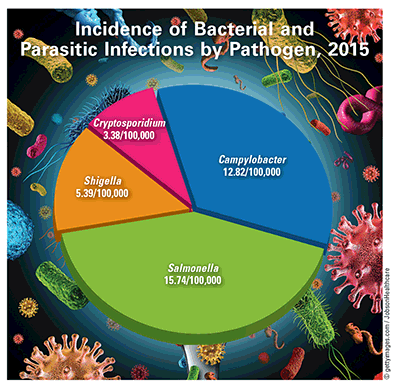US Pharm. 2017;42(12):14.
The CDC defines a foodborne disease outbreak as the occurrence of two or more similar illnesses resulting from ingestion of a common food. Each year, one in 10 people experiences a foodborne illness, 128,000 are hospitalized, 3,000 die, and 33 million healthy life-years are lost. Of the more than 250 foodborne illnesses identified, most are infections caused by a known pathogen. A variety of bacteria, viruses, and parasites, as well as harmful toxins and chemicals (5%), cause foodborne illness. Norovirus is the most common pathogen to cause illness through food contamination (42%), followed by Salmonella (30%).

Norovirus Outbreaks: Each year, 21 million people are affected by the highly contagious Norovirus, which causes an infected person to shed billions of viral particles. Norovirus activity was unusually high in 2016–2017 during its seasonal period (December to March). Norovirus outbreaks from food contamination occurred in many different settings: schools and daycare (1%), healthcare facilities (1%), private residences (4%), catering/banquet facilities (17%), and restaurants (64%). Two-thirds of outbreaks in healthcare facilities occurred in nursing homes. Of all Norovirus outbreaks, 1% occurred on cruise ships (70% of episodes were attributed to infected food workers). Each year, 800 people die from Norovirus infection, most of them aged 65 years or older.
Salmonella Outbreaks: The most common cause of gastroenteritis is Salmonella infection. Annually, nontyphoidal Salmonella causes 1.2 million cases of foodborne illness (12.6%), 23,000 hospitalizations, and 450 deaths. Most Salmonella outbreaks were attributed to seeded vegetables (6.9%), pork (4%), or vegetable row crops (1.7%). Culture-confirmed Salmonella cases jumped by 10% between 2013 and 2014 (12.3 cases/100,000 in 2013 and 13.9/100,000 in 2014), and infants aged younger than 1 year still had the highest infection incidence for both boys and girls (boys, 110.2/100,000; girls, 94.2/100,000). The overall incidence (per 100,000) of Salmonella cases in 2014 was greater in females (13.92) than in males (12.86). Adults older than 65 years, people with weakened immune systems, and non-breastfed infants are more likely to have severe infections. The summer months (peaking in July or August) had the highest percentage of cases. The use of certain medications to reduce stomach acidity can increase the risk of Salmonella infection.
Campylobacter Outbreaks: Campylobacter is one of the four key global causes of diarrheal diseases. Diarrheal diseases are the most common cause of gastroenteritis resulting from unsafe food, with 550 million people falling ill each year (including 220 million children younger than 5 years). According to the FoodNet 2015 report, the incidence of Campylobacter infection was less among persons aged 10 to 19 years (7.99/100,000). Campylobacter species can be killed by thorough cooking.
To comment on this article, contact rdavidson@uspharmacist.com.






